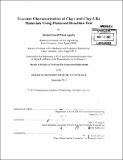Fracture characterization of clays and clay-like materials using flattened Brazilian Test
Author(s)
Agaiby, Shehab Sherif Wissa
DownloadFull printable version (27.69Mb)
Other Contributors
Massachusetts Institute of Technology. Department of Civil and Environmental Engineering.
Advisor
John T. Germaine.
Terms of use
Metadata
Show full item recordAbstract
Fracture mechanics has been used for many years to study the mechanical behavior of brittle and quasi-brittle materials like concrete, rock, wood, and ceramics. To date, the application of fracture mechanics to soils has been limited to dry and partially saturated soils where soil consistency changes due to suction and tends to be harder exhibiting a quasi-brittle behavior. Of late, studying fracture propagation in clays and mudrocks has become of interest as it provides a means to extract oil from oil bearing strata. While crack initiation in soils can be analyzed using basic soil mechanics theories, development and propagation of a crack is energy driven and requires application of fracture mechanics principles. An essential parameter in Linear Elastic Fracture Mechanics (LEFM), the main analytical tool in studying fracture in rock, is the critical stress intensity factor that defines stress concentration near a crack tip beyond which a fracture would propagate. The basic mode of crack loading can be obtained by applying a normal stress that has a corresponding opening mode of crack surface displacement, called mode-I (tensile mode), with a critical stress intensity factor termed fracture toughness, denoted by KIC. In this experimental research, KIC is measured indirectly using a modified Brazilian Test configuration where load is applied normally on flattened Brazilian disk specimens without the need to introduce a flaw into the specimen. Intact natural specimens from four different deposits; Boston Blue clay, San Francisco Bay Mud, Presumpscot Maine clay, and Gulf of Mexico clay; are tested in oven-dried state under atmospheric conditions. In addition, two Clay-like materials; molded Gypsum and Plaster of Paris; have been investigated. Based on the analysis of the test data, the relation between mode I fracture toughness and tensile strength for the six tested materials agrees to a great extent with reported trends in the literature even for different fracture toughness and tensile strength testing techniques and for wider tested range of soils, rocks, geomaterials, clay-like, and rock-like materials. However, no clear relation between mode I fracture toughness and elastic modulus or any other physical parameter was determined.
Description
Thesis: S.M., Massachusetts Institute of Technology, Department of Civil and Environmental Engineering, 2013. Cataloged from PDF version of thesis. Includes bibliographical references (pages 243-251).
Date issued
2013Department
Massachusetts Institute of Technology. Department of Civil and Environmental EngineeringPublisher
Massachusetts Institute of Technology
Keywords
Civil and Environmental Engineering.